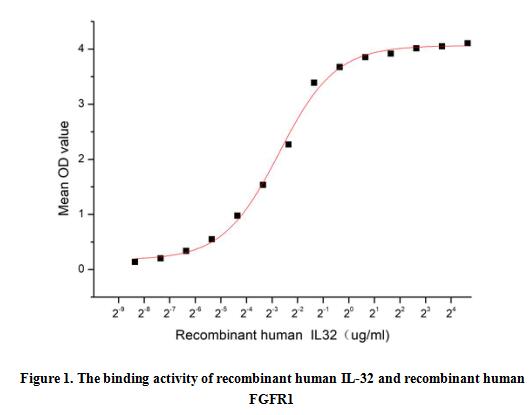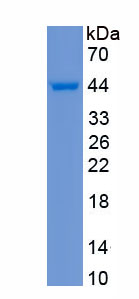Active Interleukin 32 (IL32) 

NK4; TAIF; TAIFb; TAIFd; Natural Killer Cell Transcript 4; Natural killer cells protein 4; Tumor necrosis factor alpha-inducing factor
- UOM
- FOB US$ 213.00 US$ 533.00 US$ 1,066.00 US$ 3,198.00 US$ 7,995.00
- Quantity
Overview
Properties
- Product No.APB802Hu02
- Organism SpeciesHomo sapiens (Human) Same name, Different species.
- ApplicationsCell culture; Activity Assays.
Research use only - DownloadInstruction Manual
- CategoryCytokineInfection immunityBone metabolism
- Buffer FormulationPBS, pH7.4, containing 0.01% SKL, 5% Trehalose.
- Traits Freeze-dried powder, Purity > 80%
- Isoelectric Point4.5
Sign into your account
Share a new citation as an author
Upload your experimental result
Review

Contact us
Please fill in the blank.
Activity test

Interleukin-32 (IL-32) is an interleukin cytokine usually linked to inflammation. The IL-32 transcript is expressed in various human tissues and organs such as the spleen, thymus, leukocyte, lung, small intestine, colon, prostate, heart, placenta, liver, muscle, kidney, pancreas, and brain. Cytokines are critical components of cell signaling pathways that are involved in the regulation of cell growth, metabolism, hormone signaling, immune regulation and a variety of other physiological functions. FGFR1 has been identified as an interactor of IL-32, thus a functional binding ELISA assay was conducted to detect the interaction of recombinant human IL-32 and recombinant human FGFR1. Briefly, IL-32 was diluted serially in PBS with 0.01% BSA (pH 7.4). Duplicate samples of 100 μl were then transferred to FGFR1-coated microtiter wells and incubated for 1h at 37℃. Wells were washed with PBST and incubated for 1h with anti-IL-32 pAb, then aspirated and washed 3 times. After incubation with HRP labelled secondary antibody for 1h at 37℃, wells were aspirated and washed 5 times. With the addition of substrate solution, wells were incubated 15-25 minutes at 37℃. Finally, add 50 µL stop solution to the wells and read at 450/630nm immediately. The binding activity of recombinant human IL-32 and recombinant human FGFR1 was shown in Figure 1, the EC50 for this effect is 0.15 ug/mL.
Usage
Reconstitute in 10mM PBS (pH7.4) to a concentration of 0.1-1.0 mg/mL. Do not vortex.
Storage
Avoid repeated freeze/thaw cycles. Store at 2-8°C for one month. Aliquot and store at -80°C for 12 months.
Stability
The thermal stability is described by the loss rate. The loss rate was determined by accelerated thermal degradation test, that is, incubate the protein at 37°C for 48h, and no obvious degradation and precipitation were observed. The loss rate is less than 5% within the expiration date under appropriate storage condition.
Increment services
-
 BCA Protein Quantification Kit
BCA Protein Quantification Kit
-
 Molecular Mass Marker for Protein
Molecular Mass Marker for Protein
-
 Monoclonal Antibody Customized Service
Monoclonal Antibody Customized Service
-
 Polyclonal Antibody Customized Service
Polyclonal Antibody Customized Service
-
 Protein Activity Test Experiment Service
Protein Activity Test Experiment Service
-
 Electrophoretic Mobility Shift Assay (EMSA) Experiment Service
Electrophoretic Mobility Shift Assay (EMSA) Experiment Service
-
 Buffer
Buffer
-
 Lentivirus Packaging Experiment Service
Lentivirus Packaging Experiment Service
-
 Adenovirus Packaging Experiment Service
Adenovirus Packaging Experiment Service
-
 Real Time PCR Experimental Service
Real Time PCR Experimental Service
-
 Spike RBD Protein (S-RBD)
Spike RBD Protein (S-RBD)
-
 Protein G
Protein G
-
 Protein A
Protein A
Citations
- Three cases of lupus nephritis patients with serum interleukin-32γ detectionPubmed:24879659
- Clinical significance of serum interleukin-29, interleukin-32, and tumor necrosis factor alpha levels in patients with gastric cancerPubMed: 26219901
- Calprotectin in serum and zonulin in serum and feces are elevated after introduction of a diet with lower carbohydrate content and higher fiber, fat and protein contents.pubmed:28413639
- Role of several cytokines and adhesion molecules in the diagnosis and prediction of survival ofhepatocellular carcinoma.pubmed:27916547
- SERUM INTERLEUKIN-32 (IL-32) LEVELS MAY HAVE DIAGNOSTIC AND PROGNOSTIC ROLES IN PATIENTS WITH...doi:10.19193/0393-6384_2017_4_091
- Calprotectin in serum and zonulin in serum and feces are elevated after introduction of a diet with lower carbohydrate content and higher fiber, fat and protein contents10.3892/br.2017.865
- High Fiber Fat and Protein Contents Lead to Increased Satiety Reduced Sweet Cravings and Decreased Gastrointestinal Symptoms Independently of Anthropometric Hormonal and Metabolic Factors10.4172/2155-6156.1000733
- IL-31, IL-32 and IL-33 may Serve as Diagnosis Biomarkers in Gastric Cancer







